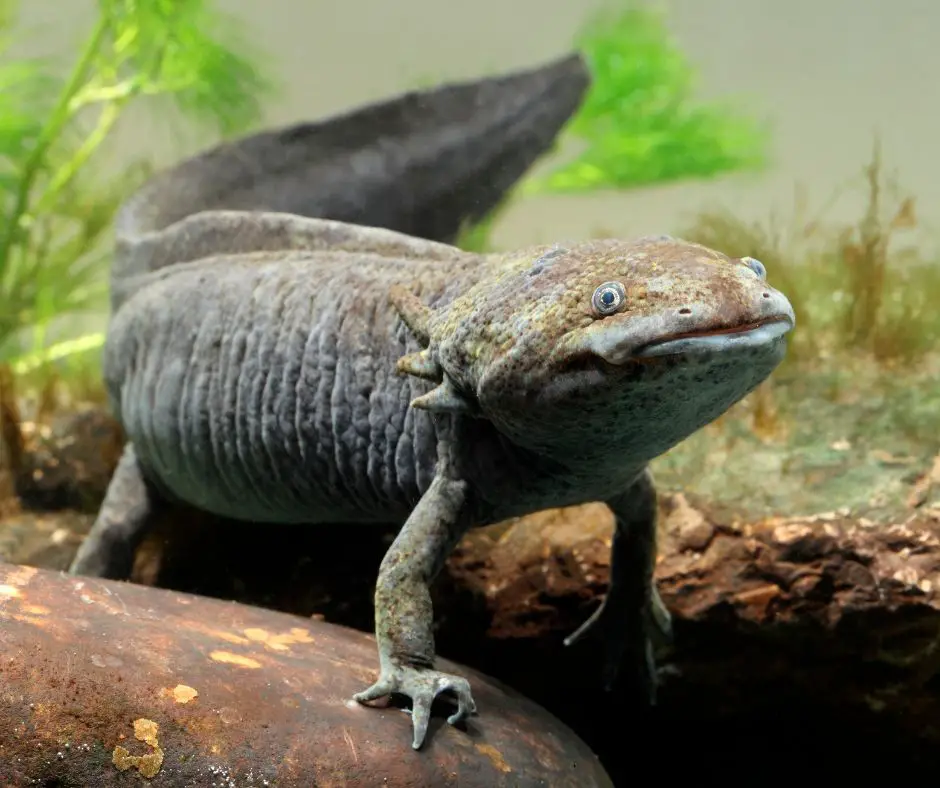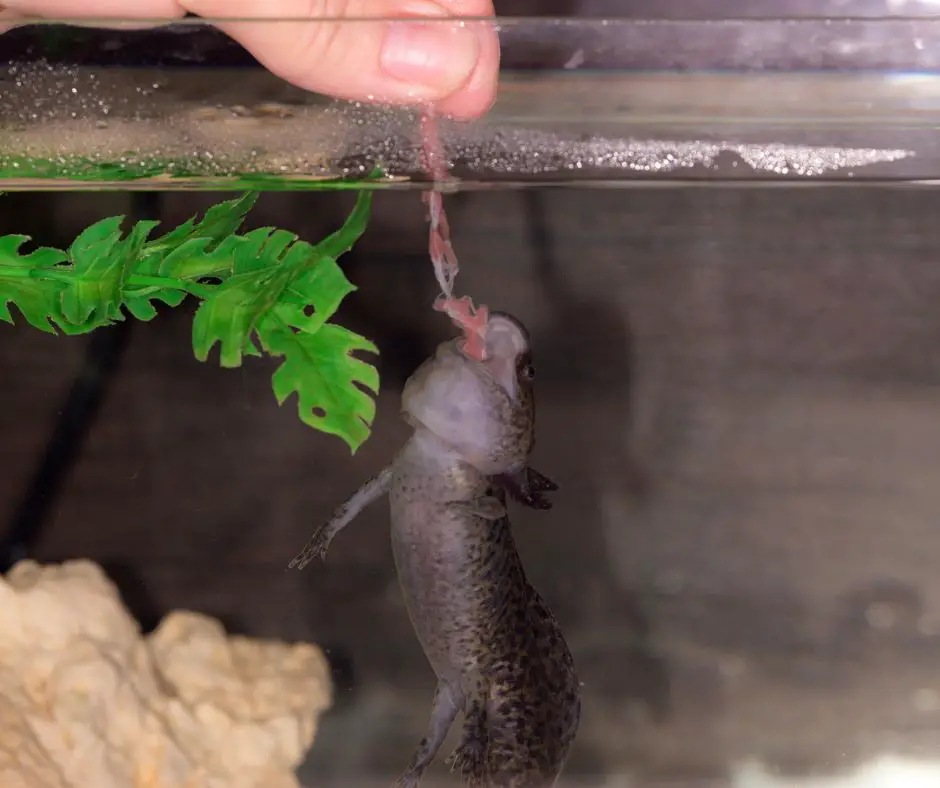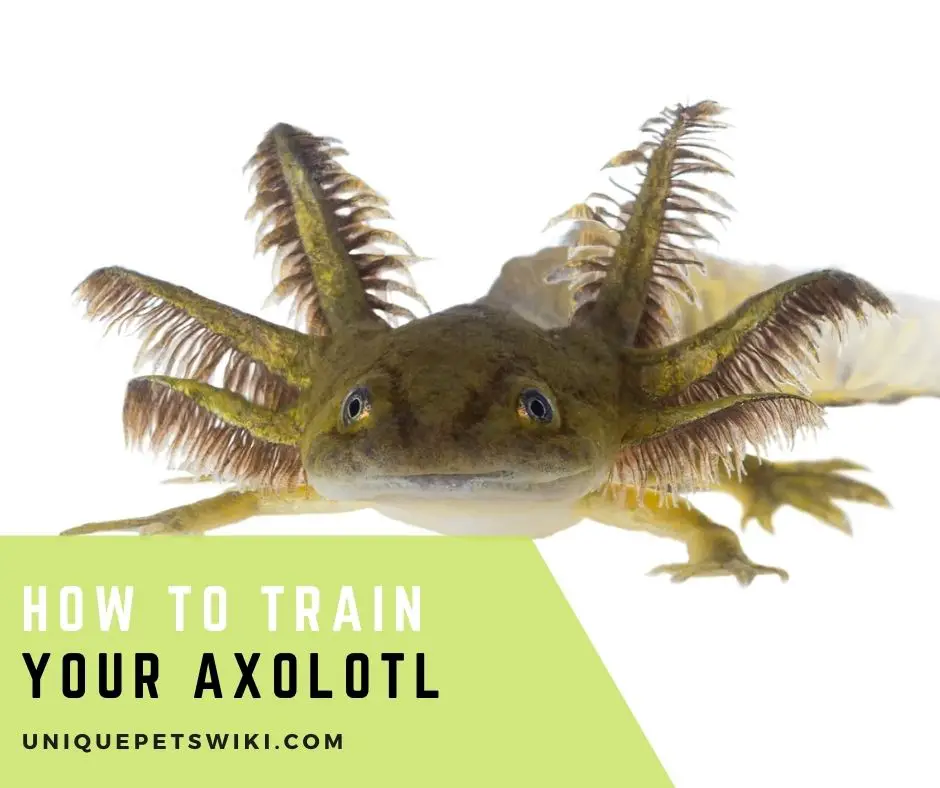Training pets is always an enjoyable experience in a long journey of caring for them, and axolotls are no exception. It only requires a few repetitions, and the axolotl starts to respond positively to the training.
Some axolotls are fussy while others are always looking for food and are more than ready to eat hence, it takes the shortest time possible to train them.
Training these creatures is necessary for many circumstances, including feeding.
Here, I will spell out on how to train your axolotl to hand feed, dish-feed, and eat pellets. I will also expound on the safety rules when training axolotls.
Contents
How to Train Your Axolotl?

Training axolotls is not something that will blow your mind. These animals are easy to train, and most of their training becomes successful.
However, training can be discouraging, especially when both you and the axolotl are new to each other. Axolotls are more friendly to the owners who interact with them most frequently.
How much your axie recognizes and interacts with you depends on how much you recognize and interact with it. It’s imperative to have a good rapport with your beloved companion.
Having a strong bond with your pet is one of the greatest tools when it comes to training.
For instance, if your axolotl is close to you, it will quickly swim up to your hand whenever you stick it in the water.
Below, I have thrown lights on hand feeding, dish feeding, and pellet training your captivated axolotl.
Hand Feeding

Hand-feeding your axolotl is fun and stimulating. If you move your fingers around the tank, the axolotl will follow them with enthusiasm to see what you will provide.
You can train your axolotl to hand feed, but it requires patience. To embark on the training, slowly put your fingers down in your axolotl’s aquarium, and let the pet nip at your fingers.
If it does so, go ahead and grab some of the axy’s food with your fingers and hold it under the water. The plan is for the axolotl to grab the food from your finger.
Some axolotls will snatch the food without further ado, but others seem hesitant. If your axolotl is reluctant, just wriggle the food back and forth to entice the pet to grab it.
Keep in mind that these animals have poor eyesight, and instead of using sight, they largely depend on the sense of touch and vibration in the water.
Once the axie takes the food from your finger, feel free to adapt the feeding; feed the pet in this manner every day, and they’re home free.
Every training demand consistency and determination. The rule here is to repeat, repeat, and repeat the training. Over time, your axolotl will feel comfortable feeding from your hand.
Dish Feeding
Here, you are training your pet to feed on a dish, which is doable. You need a feeding dish that is large enough for the axie to go in and out effortlessly.
Dish feeding is more advantageous because it helps contain the food inside and prevents the axolotl from eating a lot of substrates, e.g., sand.
Not only that, the dish prevents foods like pellets from making a mess of the substrate.
You don’t hold the food anywhere in the aquarium, but you put it on the feeding dish. Provide a feeding dish in the tank, grab a bite of axolotl’s food with the tweezers, and put it near the dish.
Wiggle the food for the reluctant axolotls to see it clearly. Eventually, put the food directly into the feeding dish, and let the axolotl get it.
Be patient and repeat the training many times until the axolotl is conversant with dish feeding.
3 Pieces Shrimp Feeding Tube and Dish Set
- Quality material: made of glass, this shrimp feeding tube and dish set has certain hardness and can be applied in water for a long time without getting rusted; This set would not do harm to fishes and other aquatic animals, and it would not affect the water, thus you can put it in water with no concern
- Easy to clean: designed in the shape of a tube, this glass shrimp feeding tube is convenient for you to clean the leftover feeds by rinsing it with soap and water; The aquarium shrimp feeding dish has shallow bottom, which is simple for you to reach its surfaces and clean; With smooth surfaces, the tube and dishes are easy to be cleaned
- Wide range of use: these shrimp feeder tube and fish tank feeding bowls are ideal for food feeder, and they are not only suitable for feeding fishes, shrimps, and other aquatic animals, but also can be applied in feeding reptiles like lizards, spiders, and so on; This shrimp feeder tube can keep your distance from animals while feeding them, keeping them from being frightened, and protecting your hands from harm
- Convenient to use: this combination of aquarium feeding tube and clear tank feeding bowls is useful, allowing you to take feeds with the tube and place them on the clear tank feeding bowls; Placing the clear tank feeding bowls in a fish tank or other containers, the bowls can protect the feeds from falling into other places in the tank and sweeping away
- Quantity and size: this package includes 1 piece feeder tube and 2 pieces feeder basins, and the approximate length of the feeder tube is 20 cm/ 7.87 inch; Among the 2 pieces feeder basins, there are 2 sizes, namely approx. 6 cm/ 2.36 inch and 6.5 cm/ 2.56 inch in diameter, which is a suitable size for food feeder
Last update on 2023-01-02 / Affiliate links / Images from Amazon Product Advertising API
Pellet Training Your Axolotl
Pellets are suitable foods for axolotl. They are readily available and highly nutritious, so many caretakers love using them.
If your friend is eating pellets for the first time, the chances of rejecting the food are high. It needs to be familiar with pellets, which is possible through training.
One way to feed axolotls with this feeding material is by holding it above their nose. Try the pellets just above your axolotl’s nose one by one. The pet will grab the pellet right away or drag itself.
You can leave one or two pellets in the water overnight, hoping that the lotl will find them. Axolotls are more active and busier during the dark hours and can locate their food through smell.
Avoid feeding the axolotl pellets alongside their usual food if it’s the first time. You can provide the latter the next day.
Doing this will prevent the axolotl from thinking that it will get its favorite snack if it ignores the pellet.
The best thing would be to alternate pellets with normal feedings. If the axolotl won’t touch the pellets on your third day, getting a better pellet is advisable. Provide the pellets gradually and perpetually.
Also read: How Many Pellets To Feed Axolotl
Safety Rules When Training Axolotls
Training axolotls is not tricky, but you might regret it if you do it carelessly. These creatures are so delicate that you need to be extremely cautious when dealing with them.
Your hands should be clean throughout your training. Working with unwashed hands can be dangerous since you might be carrying foreign substances that are infectious to axolotls.
So then, please wash your hands before and after feeding the axolotl to keep its water clean and secure.
It is also imperative to check the size of food you’re feeding. The food needs to be small enough for your lotl’s mouth to avoid choking.
Also, remember that axolotls don’t know how to chew food; instead, they swallow them whole.
Don’t feed your axolotl frequently. These animals don’t need to eat often since you can easily overfeed them.
Wait until your axie is hungry. They are more active when hungry; some dance on the glass when they see you to beg for food.
Check out: How Often Do Axolotls Eat?
Is it Okay to Touch Your Axolotl?
Every caretaker will enjoy touching their axolotl. While we find pleasure in touching or holding these cute companions, it is not suitable for them.
Axolotls are one of the most delicate pets that exist. Their bodies are susceptible. Likewise, removing your axolotl outside water to give you company is not good at all.
The legs of these amphibians are not designed to support their body weight since they are usually suspended in water.
An axolotl’s skin is delicate and vulnerable to nicks and tears. The skin can also absorb foreign substances that will cause them to be sick. Axolotls don’t like to be touched, and you stress them if you persist.
Your axolotl can choose to touch you, and this is pretty okay. But you touching them is not recommended.
Acrylic Coral Spot Feeder Long Tube
- Aquarium feeding set: the package includes 1 piece coral feeder tube and 2 pieces straight and curved tweezers, nice combination for feeding your little pets in the water; The stainless steel straight and curved tweezers can both feed and clean up the mess inside the fish tank
- Reliable material: the coral spot feeder is made of quality acrylic and rubber material, which is safe for fish and corals, simple to clean and not easy to crack; the aquarium feeding tongs are made of stainless steel with black coating, durable and not easy to be rusted under water, with the help of serrated tips, the tweezers can grip stuff securely without slipping off
- Appropriate size: the size of coral feeder is approx. 13.77 inch/ 35 cm, long tube help you arrive at deep and hard-to-reach area, and the tweezers are approx. 10.62 inch/ 27 cm in length, they are great and practical tools for aquarium plants or reptiles
- Wide applications: you can feed liquid phytoplankton to corals or other aquatic animals by using coral feeder and tweezers, which is easy to control and prevents your hands from getting wet, these feeding tools can be applied in marine reef tank to feed coral, reef, anemones, lionfish, brine shrimp, watchman goby and so on
- Warm tips: pleas ensure that the coral feeder tube is washed and cleaned before use; Turn off your circulation pumps when feeding your coral or fish; When applied it in hot water, the temperature of the liquid should not exceed 176 degrees Fahrenheit; After using tweezer, please remember to rinse it with water and dry
Last update on 2022-12-29 / Affiliate links / Images from Amazon Product Advertising API
FAQs
Do axolotls like to be held?
One thing that axolotls hate much is being held. These animals are skittish and fearful and do not like to be picked up even by their owners.
You should only hold when there is a need to do so. For example, when cleaning the tank or during medication.
How do I make my axolotl happy?
You can make your axolotl happy by ensuring it lives in a stress-free environment. And to achieve this, you need to maintain all the tank parameters at their correct level. Also, axolotls are happy if fed well.
Can you play with a pet axolotl?
Yes, it’s possible to play with a pet axolotl. You can do this by putting your hand in the tank of the axolotl; the axolotl will play with it. But avoid touching it at all means.
What tricks can axolotls learn?
Most axolotls will stop shying away from you once they become close to you. In such circumstances, the axolotl can learn certain tricks like eating out of your hand, swimming to the tank’s top, and swimming in a pattern prior to feeding.
Final Words
Axolotls are interactive animals but not to everyone. Your axie will recognize and feel okay around you depending on the time you spend together.
If your axolotl sees you only when you’re feeding it and then disappear within seconds, it will be uncomfortable and shy anytime you approach the tank.
However, some axolotls are less social than others, and it changes nothing even after giving them a lot of your attention. Some are more interactive and friendly than others.
Feeding your axolotl is a neat way to interact with it. Axolotls are typically not shy about food and will mostly grab it immediately after it’s provided.
However, some axies need more training time until they become interested in the food.


